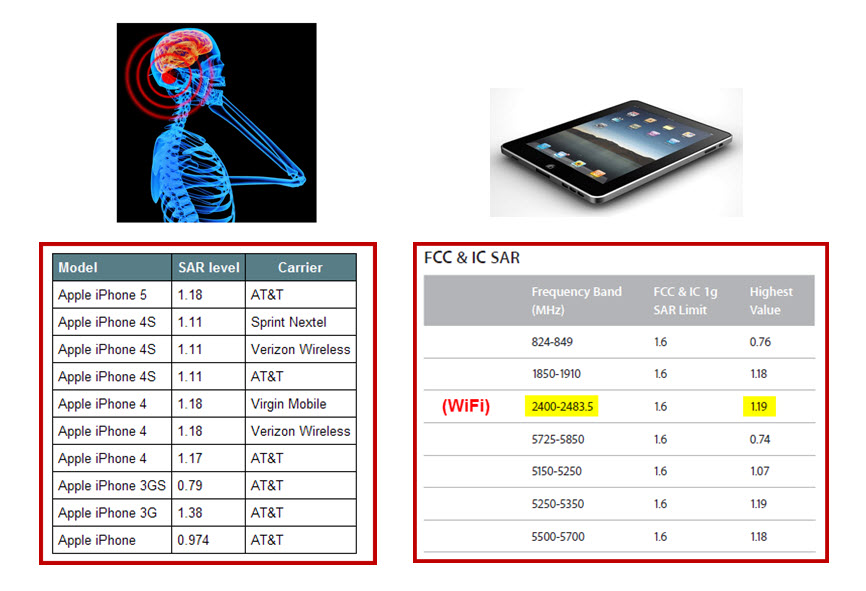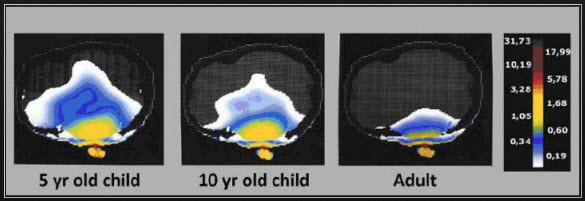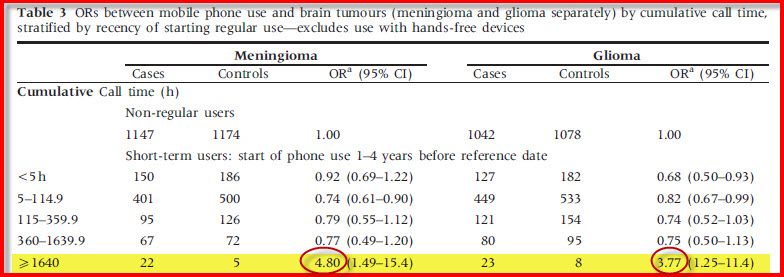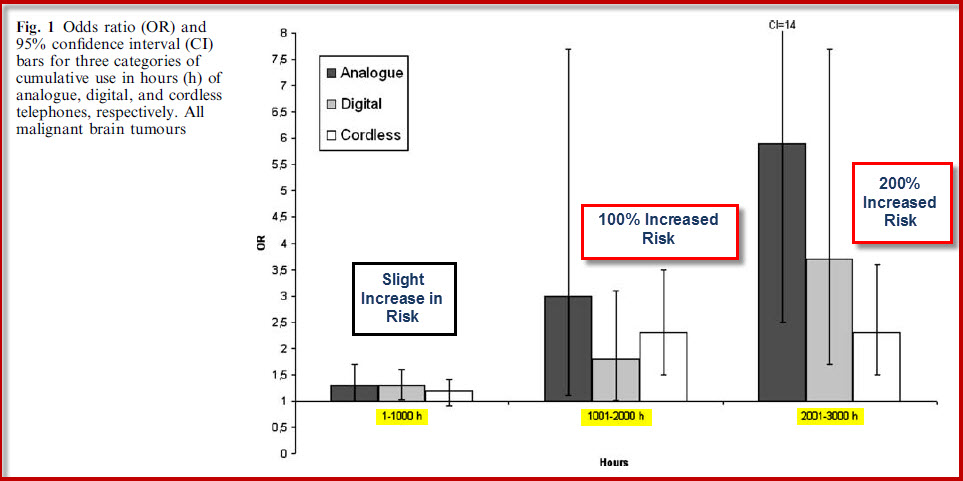Make no bones about it, the dosage is higher than a kite and it is not what the doctor ordered. Are your kids at risk at school in these wireless classrooms with the schools using commercial or industrial grade routers that broadcast on several frequencies at the same time? You want your kids slouched over an in use wireless radiation emitting cell phone all day? How about at home or everywhere else with these things right in front of their heads and in their laps all the time? That is exactly what your children are doing at school and at home. These tablet devices are microwave transmitters and emit wireless radiation trillions of times the normal background levels that many of us and our parents were exposed to as children.
What will it take to get the parents to act . I think that there are many obstacles, not the least of which is them dealing with the fact that they themselves have been irradiating their children since the beginning. So if they acknowledge this as harmful, then they have to deal with their guilt. It is time to deal with reality, swallow the pride and put your children ahead of your fears, the school administrators and your fair weather friends ladies and gentlemen. We are talking about your kids, a trillion dollar industry that doesn’t give a rat’s behind about them, and school administrators that will do whatever they are ordered to do without batting an eye.
Let us begin.
In this chart, we can see that for those that used a cell phone for over 1640 hours in 1-4 years, meaning about an hour a day, had an OR of 4.8 for developing a meningioma brain tumor and an OR of 3.77 for developing a glioma.
_____________________________________________________________________________________________
Hardell L, Carlberg M, Hansson Mild K. Pooled analysis of two case-control studies on
use of cellular and cordless telephones and the risk for malignant brain tumours
diagnosed in 1997-2003. Int Arch Occup Environ Health 2006
It takes a certain amount of exposure for brain tumors to start to appear. In this chart by a Swedish team of independent researchers lead by Lennart Hardell, there was only a slight increase in risk from using a cell phone 1-1000 hours. The brain tumor risk really jumped, however, after 1000 hours of usage, and was much higher with prolonged usage.
According to the science, using a cell phone for over 1000 hours leads to an increased risk of brain cancer. According to the manufacturer, iPads emit as much or more radiation than cell phones. According to research, children absorb more radiation than adults. Given this evidence, what will happen to these children who spend at least 4 hours a day on an iPad at school, followed by another 4 hours at home? This is at least 2000 hours each and every year, and at least 12,000 hours of exposure in elementary school alone.
Papers finding adverse biological effects such as impaired fertility or damage to health from Wi-Fi signals, Wi-Fi-enabled devices or Wi-Fi frequencies (2.4 or 5 GHz).
Avendaño C. et al., 2012. Use of laptop computers connected to internet through Wi-Fi decreases human sperm motility and increases sperm DNA fragmentation. Fertility and Sterility 97(1): 39-45.http://www.ncbi.nlm.nih.
Aynali G. et al., 2013. Modulation of wireless (2.45 GHz)-induced oxidative toxicity in laryngotracheal mucosa of rat by melatonin. Eur Arch Otorhinolaryngol 270(5): 1695-1700.http://www.ncbi.nlm.
Gumral N. et al., 2009. Effects of selenium and L-carnitine on oxidative stress in blood of rat induced by 2.45-GHz radiation from wireless devices. Biol Trace Elem Res. 132(1-3): 153-163. http://www.ncbi.nlm.
Havas M. et al., 2010. Provocation study using heart rate variability shows microwave radiation from 2.4GHz cordless phone affects autonomic nervous system. European Journal of Oncology Library Vol. 5: 273-300.http://www.icems.eu/
Maganioti A. E. et al., 2010. Wi-Fi electromagnetic fields exert gender related alterations on EEG. 6th International Workshop on Biological Effects of Electromagnetic fields.http://www.istanbul.
Margaritis L.H. et al., 2013. Drosophila oogenesis as a bio-marker responding to EMF sources. Electromagn Biol Med., Epub ahead of print.http://www.ncbi.nlm.nih.
Naziroğlu M. and Gumral 2009. Modulator effects of L-carnitine and selenium on wireless devices (2.45 GHz)-induced oxidative stress and electroencephalography records in brain of rat. Int J Radiat Biol. 85(8): 680-689. http://www.ncbi.nlm.
Nazıroğlu M. et al., 2012. 2.45-Gz wireless devices induce oxidative stress and proliferation through cytosolic Ca2+ influx in human leukemia cancer cells. International Journal of Radiation Biology 88(6): 449–456.http://www.ncbi.nlm.
Oksay T. et al., 2012. Protective effects of melatonin against oxidative injury in rat testis induced by wireless (2.45 GHz) devices. Andrologia doi: 10.1111/and.12044, Epub ahead of print.http://www.ncbi.nlm.nih.
EMF Refugee:
The International Coalition for an Electromagnetic Safe Planet (IC-ESP)
“The further a society drifts from the truth, the more it will hate those that speak it.”
George Orwell
Wi-Fi signals, Wi-Fi-enabled devices or Wi-Fi frequencies (2.4 or 5
GHz).Papers listed are only those where exposures were 16V/m or below.
Someone using a Wi-Fi-enabled tablet computer can be exposed to
electromagnetic fields up to 16V/m. Papers are in alphabetical order.
A file of first pages, for printing, can be found here (please pass on
to schools).Wi-Fi:
Atasoy H.I. et al., 2013. Immunohistopathologic demonstration of
deleterious effects on growing rat testes of radiofrequency waves
emitted from conventional Wi-Fi devices. Journal of Pediatric Urology
9(2): 223-229.http://www.ncbi.nlm.
internet through Wi-Fi decreases human sperm motility and increases
sperm DNA fragmentation. Fertility and Sterility 97(1):
39-45.http://www.ncbi.nlm.nih.
induce DNA fragmentation in human spermatozoa in vitro by a
non-thermal effect: a preliminary report. American Society for
Reproductive Medicine 66th Annual Meeting: O-249
http://wifiinschools.org.uk/
oxidative toxicity in laryngotracheal mucosa of rat by melatonin. Eur
Arch Otorhinolaryngol 270(5):
1695-1700.http://www.ncbi.nlm.
Gumral N. et al., 2009. Effects of selenium and L-carnitine on
oxidative stress in blood of rat induced by 2.45-GHz radiation from
wireless devices. Biol Trace Elem Res. 132(1-3): 153-163.
http://www.ncbi.nlm.nih.gov/
Havas M. et al., 2010. Provocation study using heart rate variability
shows microwave radiation from 2.4GHz cordless phone affects autonomic
nervous system. European Journal of Oncology Library Vol. 5:
273-300.http://www.icems.eu/
part 2.
Havas M. and Marrongelle J. 2013. Replication of heart rate
variability provocation study with 2.45GHz cordless phone confirms
original findings. Electromagn Biol Med 32(2):
253-266.https://www.ncbi.nlm.
Maganioti A. E. et al., 2010. Wi-Fi electromagnetic fields exert
gender related alterations on EEG. 6th International Workshop on
Biological Effects of Electromagnetic
fields.http://www.istanbul.
Margaritis L.H. et al., 2013. Drosophila oogenesis as a bio-marker
responding to EMF sources. Electromagn Biol Med., Epub ahead of
print.http://www.ncbi.nlm.nih.
Naziroğlu M. and Gumral 2009. Modulator effects of L-carnitine and
selenium on wireless devices (2.45 GHz)-induced oxidative stress and
electroencephalography records in brain of rat. Int J Radiat Biol.
85(8): 680-689. http://www.ncbi.nlm.nih.gov/
Nazıroğlu M. et al., 2012. 2.45-Gz wireless devices induce oxidative
stress and proliferation through cytosolic Ca2+ influx in human
leukemia cancer cells. International Journal of Radiation Biology
88(6): 449–456.http://www.ncbi.nlm.
Nazıroğlu M. et al., 2012b. Melatonin modulates wireless (2.45
GHz)-induced oxidative injury through TRPM2 and voltage gated Ca(2+)
channels in brain and dorsal root ganglion in rat. Physiol Behav.
105(3): 683-92.http://www.ncbi.nlm.
Oksay T. et al., 2012. Protective effects of melatonin against
oxidative injury in rat testis induced by wireless (2.45 GHz) devices.
Andrologia doi: 10.1111/and.12044, Epub ahead of
print.http://www.ncbi.nlm.nih.
Papageorgiou C. C. et al., 2011. Effects of Wi-Fi signals on the p300
component of event-related potentials during an auditory hayling task.
Journal of Integrative Neuroscience 10(2): 189-202.
http://www.ncbi.nlm.nih.gov/
(Wi-Fi alters brain activity in young
adults:http://wifiinschools.
Shahin S. et al., 2013. 2.45 GHz Microwave Irradiation-Induced
Oxidative Stress Affects Implantation or Pregnancy in Mice, Mus
musculus. Appl Biochem Biotechnol 169: 1727–1751.
http://www.ncbi.nlm.nih.gov/
Türker Y. et al., 2011. Selenium and L-carnitine reduce oxidative
stress in the heart of rat induced by 2.45-GHz radiation from wireless
devices. Biol Trace Elem Res. 143(3): 1640-1650.
http://www.ncbi.nlm.nih.gov/
A few more studies of similar microwave frequencies at low exposures
(6V/m or below):
(Not comprehensive)
Balmori A. 2010. Mobile phone mast effects on common frog (Rana
temporaria) tadpoles: the city turned into a laboratory. Electromagn.
Biol. Med. 29(1-2):31-35. http://www.ncbi.nlm.nih.gov/
Erdinc O. O. et al., 2003. Electromagnetic waves of 900MHz in acute
pentylenetetrazole model in ontogenesis in mice. Neurol. Sci.
24:111-116.http://www.ncbi.
Fesenko E. E. et al., 1999. Stimulation of murine natural killer cells
by weak electromagnetic waves in the centimeter range. Biofizika
44:737–741.http://www.ncbi.
Fesenko E. E. et al., 1999. Microwaves and cellular immunity. I.
Effect of whole body microwave irradiation on tumor necrosis factor
production in mouse cells, Bioelectrochem. Bioenerg.
49:29–35.http://www.ncbi.nlm.
Havas M. et al., 2010. Provocation study using heart rate variability
shows microwave radiation from 2.4GHz cordless phone affects autonomic
nervous system. European Journal of Oncology Library Vol. 5:
273-300.http://www.icems.eu/
part 2.
Kesari K. K. and Behari J., 2009. Microwave exposure affecting
reproductive system in male rats. Appl. Biochem. Biotechnol.
162(2):416-428.http://www.
Kesari K. K. and Behari J., 2009. Fifty-gigahertz microwave exposure
effect of radiations on rat brain. Appl. Biochem. Biotechnol.
158:126-139.http://www.ncbi.
Khurana V. G. et al., 2010. Epidemiological Evidence for a Health Risk
from Mobile Phone Base Stations. Int. J. Occup. Environ. Health
16:263–267.http://www.ncbi.
Maier R. et al., 2004. Effects of pulsed electromagnetic fields on
cognitive processes – a pilot study on pulsed field interference
with cognitive regeneration. Acta Neurologica Scandinavica 110:
46-52.http://www.ncbi.nlm.nih.
Nittby H. et al., 2008. Cognitive impairment in rats after long-term
exposure to GSM-900 mobile phone radiation. Bioelectromagnetics 29:
219-232.http://www.ncbi.nlm.
Novoselova E. G. et al., 1998. Stimulation of production of tumor
necrosis factor by murine macrophages when exposed in vivo and in
vitro to weak electromagnetic waves in the centimeter range Bofizika
43:1132–1333.
Novoselova E. G. et al., 1999. Microwaves and cellular immunity. II.
Immunostimulating effects of microwaves and naturally occurring
antioxidant nutrients. Bioelectrochem. Bioenerg.
49:37–41.http://www.ncbi.nlm.
Otitoloju A. A. et al., 2010. Preliminary study on the induction of
sperm head abnormalities in mice, Mus musculus, exposed to
radiofrequency radiations from Global System for Mobile Communication
Base Stations. Bull. Environ. Contam. Toxicol. 84(1):51-4.
http://www.ncbi.nlm.nih.gov/
Panagopoulos D. J.et al., 2010. Bioeffects of mobile telephony
radiation in relation to its intensity or distance from the antenna.
Int. J. Radiat. Biol. Vol 86(5):345-357.
http://www.ncbi.nlm.nih.gov/
Persson B. R. R. et al., 1997. Blood-brain barrier permeability in
rats exposed to electromagnetic fields used in wireless communication.
Wireless Networks 3: 455-461.
Pyrpasopoulou A. et al., 2004. Bone morphogenic protein expression in
newborn kidneys after prenatal exposure to radiofrequency radiation.
Bioelectromagnetics
25:216-27.http://www.ncbi.nlm.
Salford L. G. et al., 2010. Effects of microwave radiation upon the
mammalian blood-brain barrier. European Journal of Oncology Library
Vol.
5:333-355.http://www.icems.eu/
part 2.
Salford L. G., et al., 2003. Nerve cell damage in mammalian brain
after exposure to microwaves from GSM mobile phones. Environ. Health
Perspect. 111:881-883. http://www.ncbi.nlm.nih.gov/
http://wifiinschools.org.uk/
“Two new papers are published in Pathophysiology this fall that may be
of interest to you.
These papers are the same content as the 2012 BioInitiative Report
Chapter 20
by Martha Herbert and Cindy Sage
http://www.bioinitiative.org/
.
This counters the usual criticism that ‘it isn’t good science’ unless
it is peer-review published.
The US annual cost for autism is reported to be $137 billion.
That compares to the EU annual cost for cancer (105 billion
euros/$147 billion USD)
and to heart disease ((165 billion euros/$227 billion USD).
Staggering costs, and the prevalence of autism now in the US is one
child in 88
(one child in 50 by 2012 estimates that include the 8 yr and younger
cohort).
In 1975, it was one child in 5000. This is a 100-fold increase.
It parallels the explosive rise in wireless technologies and their
pulsed RFR. It should be
considered another possible risk factor for autism, autism spectrum
conditions and ADHD.
https://thefullertoninformer.com/carbonyl-iron-and-orange-county-the-autism-capital-of-the-state/




#1 by insert Ipad for Google Glass on August 13, 2014 - 9:39 pm
Google Glass Alert: Potential health risks from wireless radiation
The Google Glass emits more wireless radiation than most cell phones on the market, but unlike cell phone users, Glass users may be wearing this device on their heads for more than 12 hours a day putting their health at risk.
PRLog – Apr. 15, 2014 – BERKELEY, Calif. — The Google Glass emits both Wi-Fi and Bluetooth radiation. Although the Glass official web site, http://www.google.com/glass/start/, contains information warning consumers about the device’s potential interference with radio or television reception, the site provides no safety information to consumers.
As a body-worn, microwave-emitting device, Google is required by Federal law to test the Specific Absorption Rate or SAR of the Glass. This is a measure of the maximum microwave radiation absorbed by the user in 6 minutes averaged over one gram of tissue. Although Google did not post the SAR information on its web site, the Glass test reports can be found on the FCC’s web site at https://apps.fcc.gov/oetcf/eas/reports/GenericSearch.cfm by entering “A4R” in the Grantee Code field. The FCC ID for the current version of the Glass is X1.
The official test report indicates that the SAR for the Glass is much higher than the SARs for the iPhone 5, the Samsung Galaxy S5, or most cell phones on the market.
During the last year, Google improved the antenna on the Glass which resulted in an increase in the SAR from 1.11 to 1.42 watts/kilogram (W/kg). In contrast, the Samsung Galaxy S5 has a head and body SAR of 0.57 and 0.64 W/kg, respectively. The Apple iPhone 5 has a head SAR of 1.17 and a body SAR of 1.18 W/kg.
In the U.S. no personal wireless device can have a SAR that exceeds 1.6 W/kg. The SAR standard, however, was developed several decades ago in the U.S. primarily by physicists and engineers to protect users from the acute effects of the heat generated by microwave radiation. The standards do not protect users from the non-thermal effects of cell phone radiation which have been associated with increased brain cancer risk among long-term cell phone users and other health problems in the short term including electrosensitivity, sperm damage and infertility, and reproductive health risks in children.
Just because these devices are legal does not mean they are safe
Although many health researchers, including myself, have questioned the utility of assessing only a device’s SAR, currently that is all governments measure and regulate. Governments want consumers to believe that all legally marketed wireless devices are safe, and that the SAR level does not matter as long as it meets the legal standard. Yet no study has proved that exposure to low-intensity microwave radiation is safe, and thousands of peer-reviewed, published studies have found biologic effects from such exposures. The research suggests that governments need to adopt more stringent, biologically-based, standards to protect consumers’ health.
Medical and public health professionals should call on Google to end this experiment on Glass users or at least fully inform consumers of the potential long-term health risks from wearing this device.
Joel M. Moskowitz, Ph.D.
School of Public Health
University of California, Berkeley
For more information about wireless radiation health risks: http://www.saferemr.com/.
Contact
Joel Moskowitz
***@berkeley.edu
— End —